
MorganTyre
-
Posts
291 -
Joined
-
Last visited
Content Type
Profiles
Forums
Events
Gallery
Posts posted by MorganTyre
-
-
Thanks everyone for the interest.
Would it be possible to post rough estimates of time involved for the two projects above.At best I could give some rough estimates as the needlecase was for myself and I wasn't keeping track and the bellrope was a set price before I started so I wasn't keeping track there either. All in all I'd say about three hours for knotwork on the needlecase. Maybe not quite that much. Grafting always seems like it is taking longer than it is. The bellrope I probably have five hours in to (once again probably a high-ish estimate) Making up the pudding takes more time than one would think. All those damn constrictor knots.... As for pricing - I normally figure about $10 an hour + materials so that needlecase is probably about $30 as pictured and the bellrope about $50.
-
Here are a couple of pieces I just finished up. The one on the left is a needlecase for myself. The one on the right was a commissioned bellrope for an 8-inch bell. Both were tied with the same type of line, just #24 cotton mason line. The needlecase has been varnished, the bellrope is awaiting a finish - probably white paint.

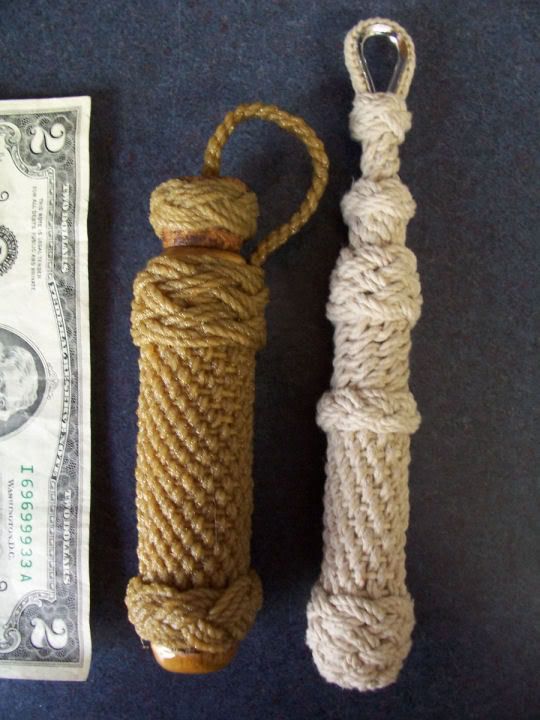
Here's the details:
Needlecase -
Case is a segment of bamboo. Cork is a shaved wine cork. Knots from top to bottom are:
3 strand flat braid (plat) for cork lanyard secured to cork with a matthew walker knot on the inside.
3x5 Turkshead on cork, tripled
6x5 Turkshead, doubled
Grafting
3x8 Turkshead, tripled
Bellrope -
Ringbolt hitching around thimble
Pudding Core
4x3 Turkshead, doubled
4 strand crown sennit
3x5 Turkshead, doubled
8 strand crown sennit
6x5 Turkshead, doubled
8strand crown sennit
3x8 Turkshead, doubled
Grafting
8x7 Turkshead, doubled
If anyone is interested I do do commissioned items though not many any my turn around time can be long (depending on how much free time I have). I typically charge by the hour. If anyone is interested just let me know (though the primary point of this post is not to drum up business). My next large project will probably be a full sized cat of nine tales complete with hand-sewn canvas bag. I'll post pictures when it's done though right now it's time to start on my Jacket project.
-
Hmm, that is interesting. Note there's a four on both of the english examples above. Very cool. I wonder where that tradition came from? I'll have to look further in to it.
-
Here's a sample of what I'm looking for. Below is an image of the logo of the Duct East India company (Vereenigde Oostindische Compagnie ) 1602-1800. Note, the A at the top specifies Amsterdam and wasn't always present in the logo.
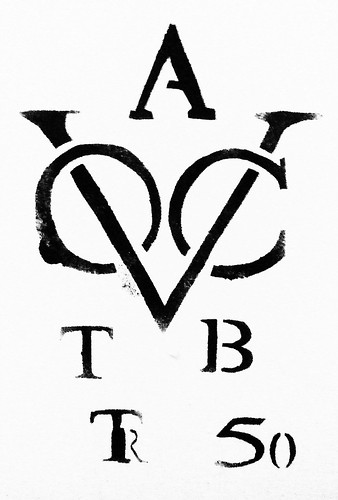
-
Take a look at the bottom right hand of that famous image of Teach:
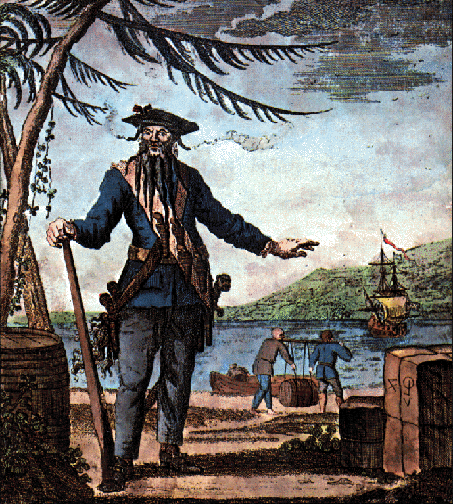
Do we know what company or merchant the symbol on that bale represents? Is it a symbol at all or an artists mark? If it is a mark of ownership, what other ones are known and documented? Was the East India Company icon featured in Pirates of the Caribbean historical? If not, how did they mark their goods? I'm trying to put together a collection of these images.
-
Well, I recieved my pattern from Kass the other day and I thought I'd start a thread to track my progress.
Step, the first:
I have to say, as a whole dealing with Reconstructing History has been a pleasure. We experienced a small technical hiccup - the sort of which I've experienced before (I also work in a company with an internet presence) but was a first for Kass - she handled it perfectly, communication was clear between us via e-mail, and I got my pattern in very short order. The pattern itself appears well laid out and I see no obvious problems but of course I wont know for sure until I start putting things together. In addition to the pattern there was a well written article giving historical details as well as extant examples putting everything in the corrent context. The instructions on the otherhand seem slightly vague but I think this is probably much more due to my inexperience than any actual problem with the instructions. I expect everything to clear once I start putting needle to cloth. All in all, I'd say it was well worth the money - this doesn't come lightly as the price tag seems (emphasis on seems) steep and I'm a cheap bastard.
I spent yesterday looking for fabric in my area. Hancock fabrics has a good, relatively light weight wool twill for about $10 a yard and I was able to find some linen CHEAP ($4 a yard) in a dark corner of JoAnn's. My plan is to first make a close fitting vest - sleeveless and collarless first to get me through the South Texas fall and then hopefully get a full jacket (looser fit, collar and probably turn back sleeves) done by winter. For the vest I'm hoping I can get away with two yards of fabric versus the reccomended 3 yards but I wont know for sure until I take a closer look and measure things out. I'll use this thread to keep you posted and get pictures up to track my progress.
-
Quoting from the text:
The Ruler may be of any length, with a largh Slit in the middle for a Slider to move in, and in the Slider a Hole to look throught: The Ruler must be slit quite through at the bottom, and a piece of brass fastened over it; but at the top it may be left whole for half an inch or more; in which whole part, a Nut may be fastenedd, through which a Screw must pass, to raise or depress the Slider as occasion requires: On both sides of the Slit, the Ruler must be divided into Feet and tenth parts of a Footl and every one of those parts into 10 more, so then every foot will be divided into 100 parts --- Through the Center of the little Hole, a small Line must be drawn quite thro' the Slider, which will shew at what height the Sight-hole standeth from the Base Ring of the Gun --- Also there must be an Index to hang on the edge of the Ruler, and under it a small Pin, perpendicular to the Pin on which the Index hangeth; which is to set the Ruler perpendicular or upright.
Gramatical errors original, typo's and bad spelling the fault of the transcriber :)
-
I came across this in the "Seaman's Grammar and Dictionary - 1691". Is anyone familiar with this instrument? Does anyone have any photo's or illustrations of the real thing? Seems like it would be an interesting and unique thing to reproduce. It's a tad early but it's easy to imagine something comparable still being found a couple of decades later.
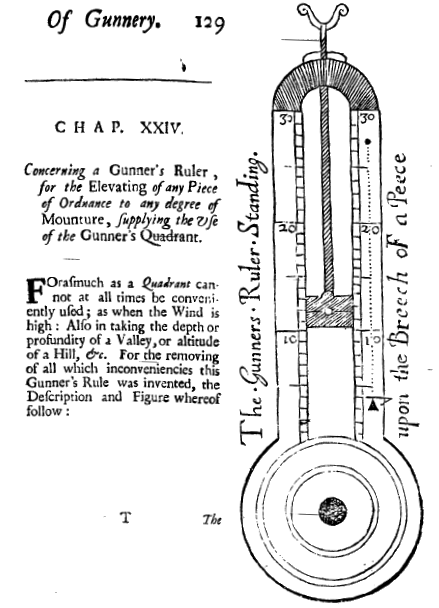
-
Thanks for the recomendation, I'll be sure to check it out. Luckily quite a few of the artifacts for the ship are housed at our local museum, of which I'm a volunteer, and at the Texas Maritime Museum which is relatively close. Very neat stuff. The marina we kept our boat at when I was a kid became the hub of the escavation. I probably sailed right over that wreck dozens of times a few decades ago.
-
I wish I were but alas there just aren't any opportunities to do that sort of thing around here. Still, I don't want faire fare - this is a very long time interest and I'd like to do it right.
-
Yeah the buttons are for the cuff. I'm not sure about the style of button that I want though. Patrick now has me kicking around the idea of making my own. Thank you all for the support and suggestions. I'm thinking I will go with the short jacket. To be honest, I was leaning in that direction before making my initial post but wanted some second opinions. Now I'm off to go read the slop contracts...
-
What time of yer do you "play" the most? If the weather is usually warm when you are out and about, you will appreciate the waistcoat more.
The weather is one of my concerns. I live in South Texas where it is always HOT HOT HOT (but at least there is a constant prevailing wind) so I was wondering which would be the cooler of the two. As for time of year, I'm at it year round. I'm also leaning towards Patricks suggestion. Would sleeveless versions of the short jacket exist? Also, much mention has been made of the slop contract. Where can I find a copy of this written out? Material choices? I imagine I'll have lots of questions. This will be my next big hand stitching project (the shirt was my first - all linen) and I have limited time.
-
Well my kit is coming together in earnest but so far it's as bare and simple as one can get. My next step will be a jacket of some sort but I'm stuck between Kass's sleeveless waistcoat (RH704) or the sailors short jacket (RH705). Any inputs as to the strength or validity of one versus the other would be well appreciated.
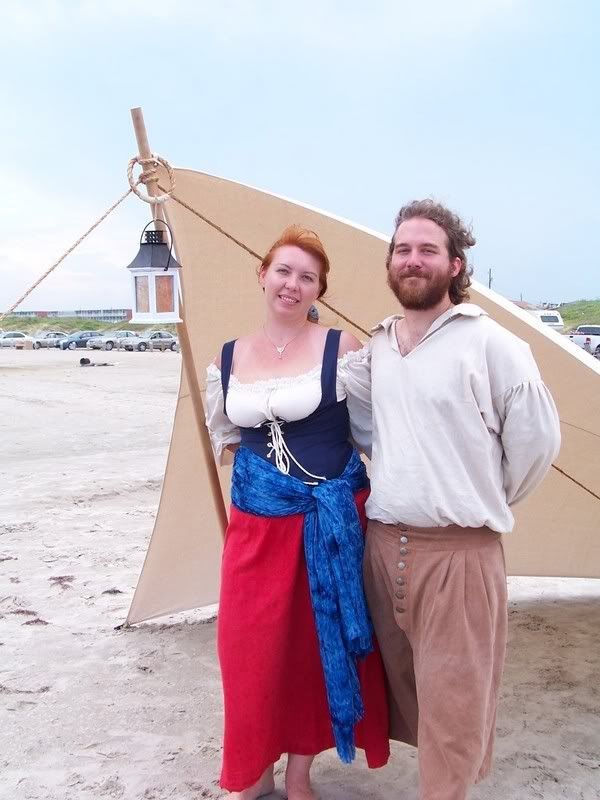
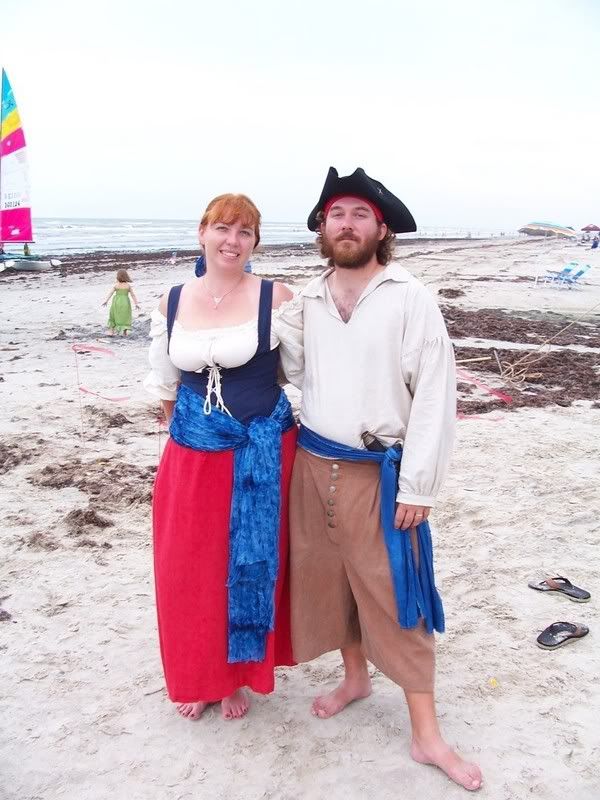
Also high on the list are stockings, shoes, a decent belt, buttons on the shirt (god I love that shirt), redo the hat, and also make a monmoth cap.
-
Were coins the only... well... coin of the realm or were any printed currency's available in the GAoP? If so, does anyone know of any good online scans?
-
Speaking of places to put it, I always liked the sketch #3825 in Ashley's.
-
I recently came across Crown and Anchor, an extremely simple dicing/gambling game which supposedly has some history in the british navy. My question is how far back does this go? Anyone have any idea? The concept is so simple it's easy to imagine it dates back as far as dice do but I know that's sloppy thinking.
-
I second the use of real blood. Pigs blood is fairly easy to come by and is basically as realistic human as you can get. Splash it on, let it dry, rinse/hand scrub then wash. It's not for the squeamish but it'll get the right look. Keep in mind that dried blood stains are more brown than anything.
-
Here's the Port Royal probate site. It'll give you approximate values.
I'm not sure what the wages were at the time. I put together the following exchange table some time ago - I doubt it's remotely accurate but it'll point you in the right direction

-
C'mon now, that's an old wive's tale. Alcohol will damage your system (liver, brains) all the same.
Nobody said anything about it not causing damage. Of course it'll kill you but these men lived hard short lives in general. I was saying that a lifelong drinker will delevop a tolerance to the inebriating effects allowing them to climb rigging, perform simple tasks, etc. I know this to be true from personal experience.
As for alcohol content - this is heavily affect by the boiling temperature of the mash and quality control couldn't have been then what it is now. If nothing else, look to modern moonshine to see how alcohol content can vary dramatically and that's with a full knowledge and understanding of the science behind the process.
-
Two things to consider - A lifetime of drinking those large quantities from relatively early childhood through death will develop a bit of a tolerance. Second, someone else brought up the the actual alcohol content of the rum. Anyone know or have any idea what the period alcohol percentage is?
-
I'd rather rely on the Oxford English Dictionary than Wikipedia
 for information. Will research what the OED has on "grog" and post...
for information. Will research what the OED has on "grog" and post...Yours, Mike
I feel like I'm getting a little beat up for quoting wikipedia - we all know that it can be a questionable resource but the reason why I quoted it was not for the info itself (which is accurate regarding the term "grog" pre-dating Vernon) but because whoever wrote that particular article summed it all up nicely and I didn't want to re-invent the wheel in coming up with a new way of stating it. All in all the grogham cloak reference being the origin of the term grog smacks of never letting the truth stand in the way of a good story. On the otherhand - if I remember correctly (and I'll have to look to my reference material to verify this) the initial dillution of the rum set off a mutiny fiasco. Does anyone recall this event?
-
In defense of the Wiki reference - that info I've all heard and read before from a variety of sources but that wikipedia article nicely summarized it.
-
Regarding the origin of the term grog... From wikipedia:
"It is very widely believed that the name "grog" came from the nickname of Admiral Edward "Old Grog" Vernon, but since the word appears in a book written by Daniel Defoe in 1718, well before Admiral Vernon's West Indian career began, and 22 years before his famous order to dilute the rum ration, this cannot be so. Significantly, it is in the 1718 book (The Family Instructor, Part II) a little former slave boy, Toby, from Barbados, who is the character using the word, stating that "the black mans" in the West Indies "make the sugar, make the grog, much great work, much weary work all day long." Since Defoe had trading interests which gave him connections at the great seaports of the day, it is likely that he had heard the word used by similar visitors to Britain from the West Indies. At any rate, the word seems to definitely have entered English from the West Indies - it may have an African origin. It is likely, therefore, that "Old Grog"'s nickname came from the drink, rather than from his cloak and that his family put about the story about the grogram cloak to cover up this minor shame. However, while the word "grog" referring to rum antedates Vernon's rations, the use of the word to refer to diluted rum may post-date him."
-
The palms on that website are (I believe) WM smith which can be bought in the US through a company called Bainbridge which any sail loft is likely to deal with. The wooden fids are a quick and easy project on a lathe - just find a nice wood you're happy with. Lignum Vitae is ideal but not necessary. The mallet I was talking about before and most other mallets as well as serving boards and mallets and seam rubbers also fall into the easy carving or turning category. Caulking irons make good first blacksmithing projects. A rigging knife similiar to the one on that website can be made by grinding down an old file. The nice thing about some of the old maritime tools is their simplicity of design - the dual advantage of which being both their easy of construction and their flexibility of use. It's these features that brought up my original question - seeing as they are as simple as simple can be and were put in the hands of people who had a TON of time on their hands - working in an industry that even by the GAoP had more than a thousand years of evolution I'm wondering just how far back most of the tools mentioned go.

Colonial gun Works
in Thieves Market
Posted
Has anyone dealt with Colonial gun works? I'm considering their queen anne pistol kit. Any thoughts? Is this the same kit that Dixie sells?